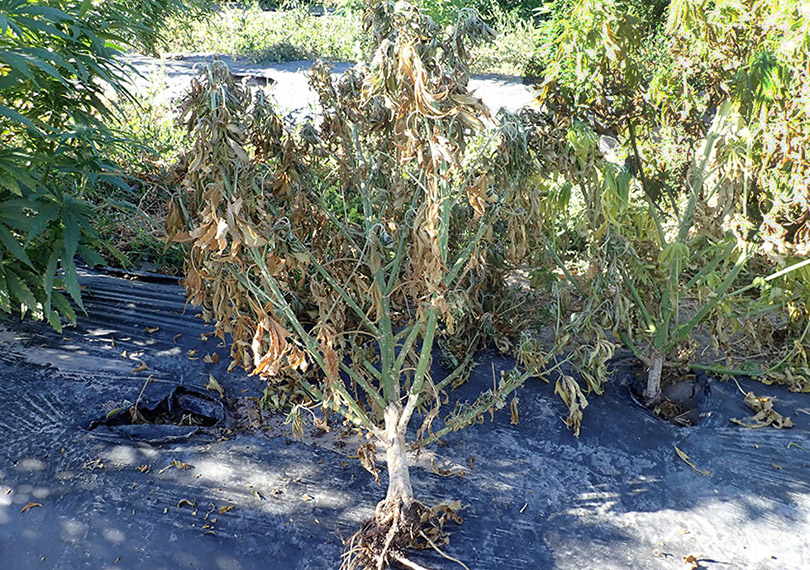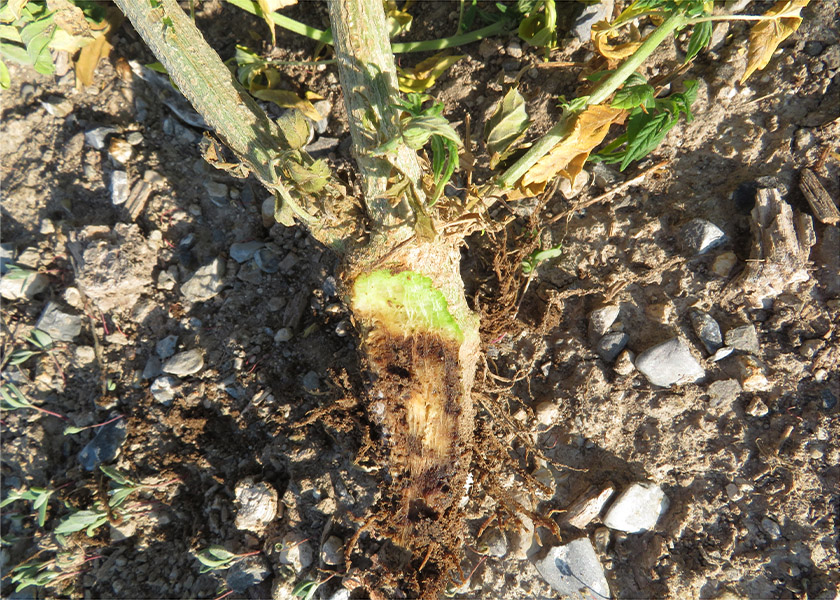Pythium Root and Crown Rot
Pythium aphanidermatum
P. dissotocum
P. myriotylum
P. ultimum
 Cross section of a hemp stem showing dead cambium (brown ring) caused by Pythium.
Cross section of a hemp stem showing dead cambium (brown ring) caused by Pythium.

Clustered dead hemp plants caused by Pythium rot spread through roots.
 Dead cambium of a pythium-infected hemp plant.
Dead cambium of a pythium-infected hemp plant.
 Pythium on a field-grown hemp plant.
Pythium on a field-grown hemp plant.
 Brown, dead cambium can be seen after scraping outer layer of the stem of an infected hemp plant.
Brown, dead cambium can be seen after scraping outer layer of the stem of an infected hemp plant.
Hosts
- Field and greenhouse-grown hemp
- P. ultimum has large host range of many vegetables and field crops.
Symptoms
Pythium species cause a root rot or a crown rot. Plants with root rot are stunted and wilted. Affected roots are rotted, and shed their outer layer, leaving only the core. Crown rot occurs when the pathogen infects the tissue at the crown, girdling the stem. Root rot does not occur in combination with crown rot. With either disease, plants quickly wilt and die.
Disease Cycle
Pythium is a soilborne, fungal-like organism that can survive as resting spores until a suitable host is present. Under saturated soil conditions, it produces zoospores that use flagella (hairlike appendages) to swim to host roots. Infection can occur with or without a wound. The pathogen colonizes the roots and/or plant crown, killing the tissue as it feeds, and forms resting spores within the dead tissue for prolonged survival. In Utah, P. ultimum can cause infection in soils with temperatures from 68-77°F and P. dissotocum causes infection in soils with temperatures between 77-86°F. Pythium species can be introduced into a greenhouse or field operation by infected transplants, contaminated soil or irrigation water, or equipment
Time for Concern
Throughout the growing season.
When and Where to Scout
- After irrigations or rains, check the field for areas of poor drainage.
- Scout plants biweekly looking for stunted, chlorotic, and wilted plants. Examine symptomatic plants for rot at the soil line.
- Plants that look very sickly or that are recently or nearly dead should be dug up. Examine roots for brown discoloration and soft root tissue where the sheath easily slides off the inner core.
- Where root or crown rot has been identified, rotate the field to a different crop.
Threat Level
Low, unless soil conditions are wet.
Occurrence in Utah
P. myriotylum prefers warmer conditions and has been found in greenhouse production in Utah. All pathogens have been isolated from hemp in Utah.
Management
- In field-grown hemp, management of crown and root rot requires prevention, because no fungicides are available.
- Use drip irrigation where possible or improve drainage in poorly-drained areas.
- Remove infected plants, including roots, in a timely manner.
Look-alikes
Drought stress, fusarium wilt or crown rot.
Photo Credits
All photos: USU Extension IPM Program

